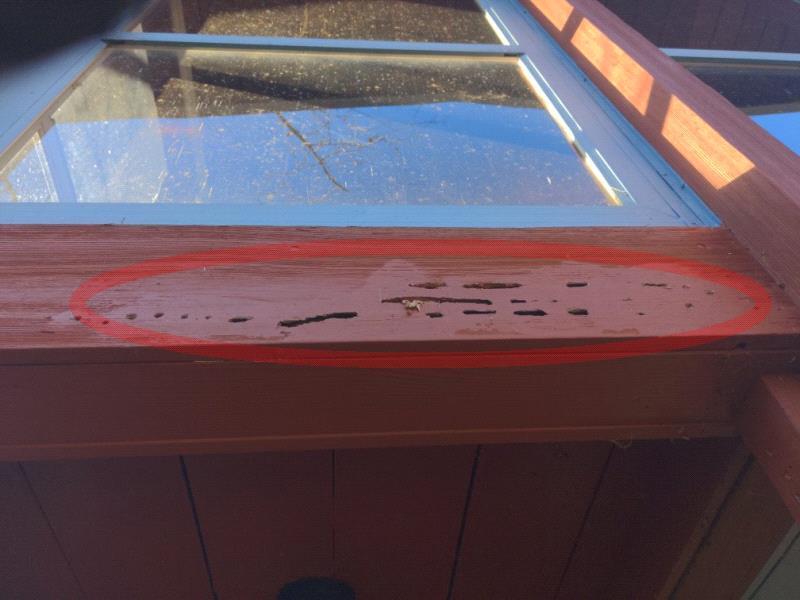New Jersey home inspectors should be familiar with identifying carpenter bees and the damage that they cause. The carpenter bee is an insect between 1/2 and 1-1/2 inches long. Carpenter bees have round bodies which are black in color. Male bees are aggressive and typically have a white or yellow face. Although the males are aggressive, they do not have a stinger. On the other hand, female carpenter bees are more subdued and do have the ability to sting. Capenter bees are often confused with bumble bees. The bumble bee has a yellow body hat is hairy and the carpenter bee has a black body. The carpenter bee is a wood destroying insect and the bumble bee is not. If you see bees hovering close to the eave areas of the home, darting in and out it is highly likely that you are looking at carpenter bees.
The female carpenter bees chew holes in exterior wood. The carpenter bee will create a hole and enter the wood about an inch. The bee will then turn and create the tunnel in the same direction as the woods grain. Carpenter bees have mandibles that they use to create the holes and tunnels in the wood. A carpenter bee tunnel is usually between 4 to six inches long. The bees will create additional sections of the tunnel called galleries. The rate at which a carpenter bee can remove wood is about an inch per week. It is in these galleries where they lay their eggs. usually, the female carpenter bees will perform all of the boring of holes and the maintenance of the nest. The female carpenter bee will defend the nest aggressively and as indicated they can sting.
Although more aggressive the male’s purpose is to mate with the females. The males can often be found hovering around flowering plants in an attempt to attract one of the female carpenter bees. As indicated the male carpenter bee is harmless and does not have a stinger. However, the male bee may be aggressive toward people, pets or anything on the move.
When there are many carpenter bee holes (nests) there will be a lot of bee larva. The larva is large and make noise in the nests attracting other pests. The most common of these pests is the woodpecker. Woodpeckers will open the holes and galleries creating more damage to the wood as the woodpeckers attempt to feed on the larva.
New Jersey home inspectors should be able to identify the damage caused by the bees. The home inspector should be able to spot and identify the holes produced by the carpenter bees. Carpenter bee holes are circular or oval in shape about the size around of an adult’s index finger. Home inspectors in NJ should also look for carpenter bee staining which is their excrement. Often there will be greenish yellow stains on the fascia areas or the eave areas of the home indicting that carpenter bees are doing their work. NJ home inspectors should also be on the lookout for active bees hovering and darting at the eave areas of the home. There are also times that carpenter bees can be heard chewing and moving from the inside of the home.
Often a professional exterminator has to be called to properly treat for the ants because they nest deep inside the wood are challenging to get too. The most common insecticide is one that contains pyrethroids. Pyrethoids are a diverse class of insecticide which are highly effective against a broad spectrum of insects. The challenging aspect of treating for carpenter bees is getting the insecticide deep into the tunnels. Carpenter bees will return to the same place year after year. This makes them challenging to get rid of permanently because you think that they were all destroyed but they often come back again. The best method to treat for the bees and keep them away for good is to have a professional pest control company treat all the bee holes. Once the bees are treated fill the holes with steel wool then caulk them over. Carpenter bees tend to prefer untreated wood so if it’s possible staining or painting the wood will help keep them away as well. Severely damaged wood or siding should be replaced if possible. These steps should help keep the bees away and help prevent more damage from occurring.
Home inspectors in New Jersey should be skilled in performing wood destroying insect inspections. Home inspectors should be able to identify carpenter bee damage and explain the process of treating for the bees to their home inspection clients.
John Martino
LookSmart Home Inspections

